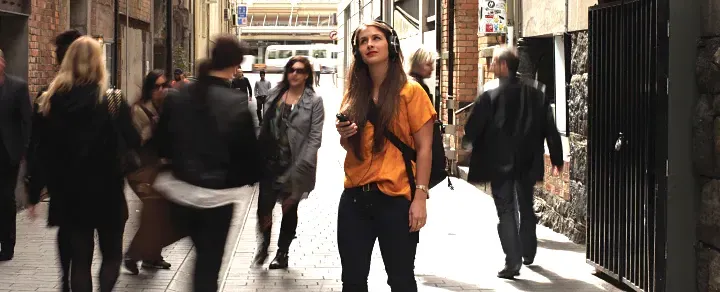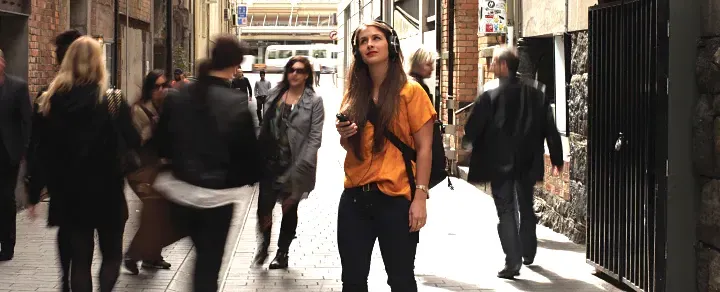Walking, Talking and Eating... En Route

Promenade theatre indulges the senses, letting the audience step into a different world. Renee Liang talks about En Route and Walk Eat Talk, both performed as part of the Auckland Arts Festival.
* * *
I’m standing on the roof of a parking building, shouting, “Peace!” down into the CBD below. I’m drunk, but not on alcohol; I’m happily, deliriously drunk on my own senses. I’m En Route. It’s one of two promenade theatre pieces performed as part of Auckland Arts Festival. The other was Walk Eat Talk, part of Dominion Rd Stories, a laudable and all too brief festival-within-a-festival that took place on the middle weekend. This, too, tickled all my senses.
The two shows couldn’t be more different, but that’s because they’re trying to do different things. Walk Eat Talk is a meticulously researched journey through time and place, a cross between a tour, street theatre and infomercial. Conceived by Yuri Kinugawa, it takes as its canvas the Balmoral stretch of Dominion Rd and is in three broad parts. The first is an audio tour which recounts the history, points out the diversity of the current inhabitants, and invites us in to observe certain businesses. The second part is a whimsical melange of performers (Asian hip hop dancers, ninja and over the top geisha) and the third is a delicious, if brief, tour for the taste buds.
While Walk Eat Talk is anchored to and informed by its location, En Route does the opposite: it manages (for me at least) to transform the drab Auckland CBD into something quite magical and timeless. This piece is also site-specific and uses local actors’ voices and local music. But something in the way it is executed – and perhaps this is related to the sensibility of its creators, UK-based collective One Step At A Time Like This – makes it feel international and almost as if I’ve been transported to another city.
But let’s start at the beginning. Both shows begin, necessarily, with a briefing. We are issued with (expensive) technology: MP3 players and headsets. We’re shown how to use them and guided through a check to make sure everything is working correctly. The briefing in Walk Eat Talk happens (efficiently, in a room with a whiteboard) before we ‘enter’ the show. In En Route I have already had my first rendezvous and am given some time to walk up the street, wondering what is going to happen, before I am accosted by a stranger who gives me equipment and suggests we ‘swap numbers.’ Through the rest of the 3 or so hours of my experience, I am guided by a range of prompts: text, audio, notes shoved in my hand or left in envelopes in various hidden locations. It’s also during En Route that I experience a temporary failure of the technology when my Ipod runs out of power (help, called for by text, arrives promptly in the form of human backup.)
Which brings me to the human element of each show. In Walk Eat Talk the people we encounter are overtly part of the show: costumed characters, actors pretending to be shop owners or the real business owners themselves. There’s a lot of mutual gawking which, it being the Asian part of town, is as it should be. There’s also, hilariously, the passers-by who have no idea what is going on – we as the audience members are in on it and happily party to the craziness. We’re guided as a group; we grin and wink at each other and share dumplings at the end as friends. I find out things about my hood that I never knew.
Right from the beginning of En Route, I have the feeling I am being silently observed – I don’t know by whom or how many, but the efficiency with which text messages arrive just when I am wondering what to do next suggests I am being guided, gently but firmly, around a preset course. Various people I meet ‘en route’ – waiters, shop staff – ignore the fact I’m dreamily walking through their space, taking photos and not buying anything. I learn at the end of the experience that there are, indeed, a group of ‘guardians’, and no doubt they have their hands full keeping up with the movements of the 8 walkers who do the course alone and at their own pace. (We are instructed at the beginning to not talk to other walkers who we see along the way – I only see one other, who silently overtakes me.) The content, length, experiences and locations are all a mystery until they happen. I find it easy to relax and just enjoy being guided – like dancing a tango with my eyes closed (someone will know what I mean.)
But my eyes in reality are far from closed. If anything, my senses are heightened, a feeling that continues until I go to bed that night. The city I thought I knew is given a poetic overlay and more than once I wonder if I’m walking in my own personal movie. I am making a movie, of sorts: we are encouraged to take photos during the walk so my hands are busy with my phone, a photographic memoir of my renewed city. I take photos of things I would never even think to take ordinarily: a makeup display at Smith and Caughey’s; chandeliers inside a design store; a chef taking a fag break out the back. I walk through private corridors unchallenged. Because I think everyone I see is in on it, I’m brazen in what I stare at, where I aim my camera. I catch snatches of poetry running through my head. A man grabs my hand and runs me down a mall, our arms outstretched. I order a coffee without paying for it.
So there you have it. Two shows, two very different walks. I enjoyed them both and left feeling inspired, so inspired that now I’m wondering about making something of my own. I couldn’t recommend it more highly than that.

